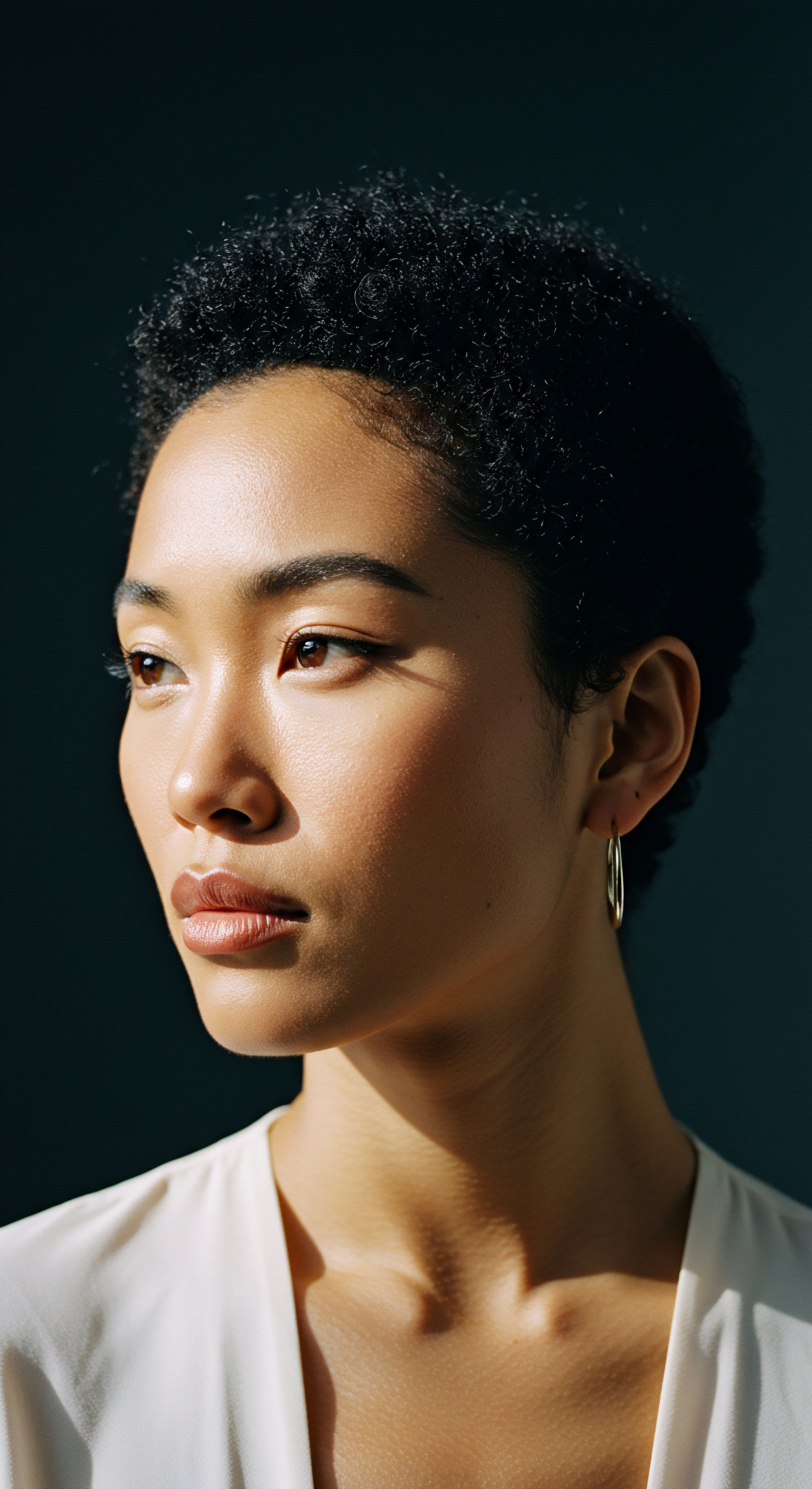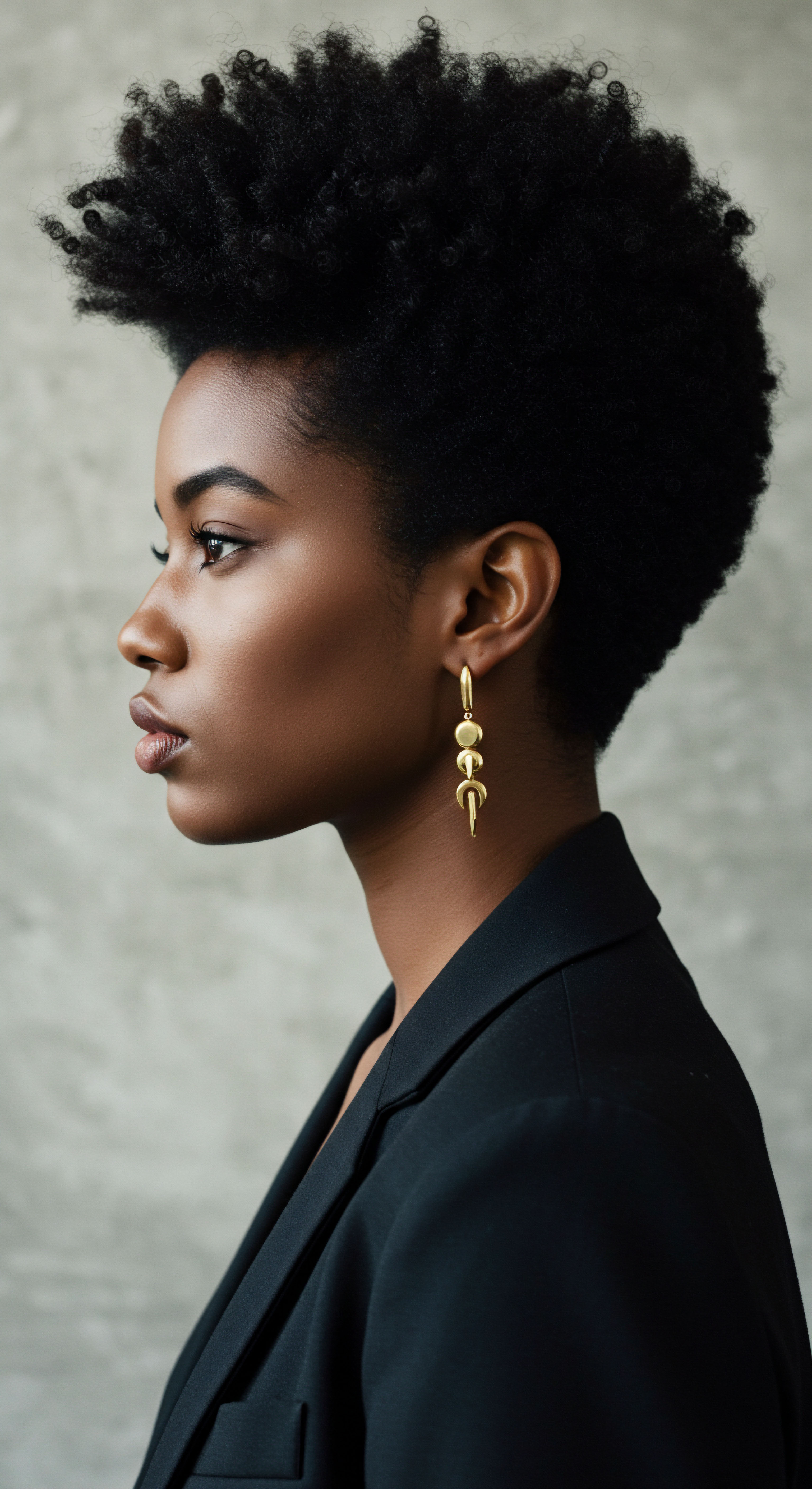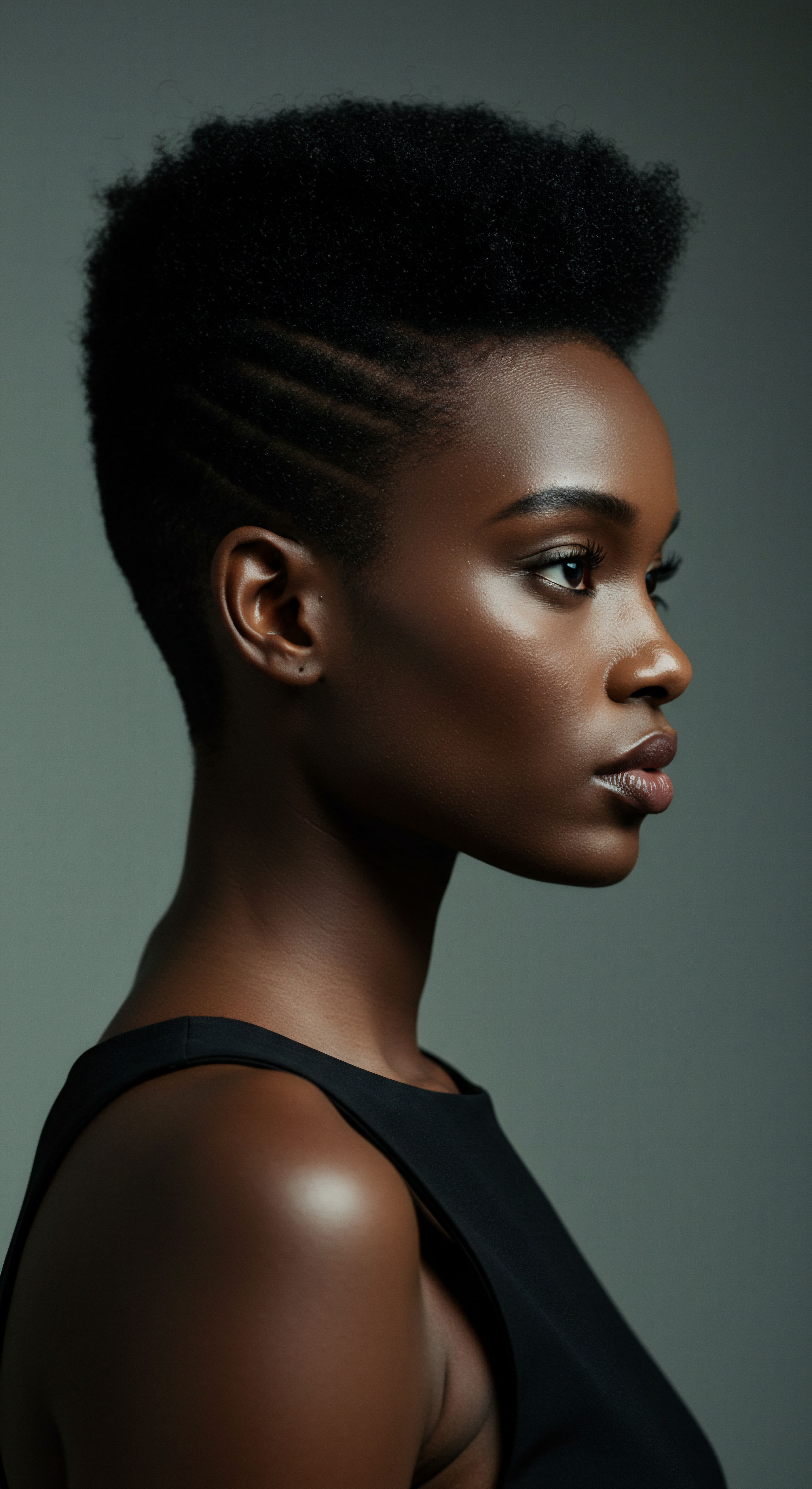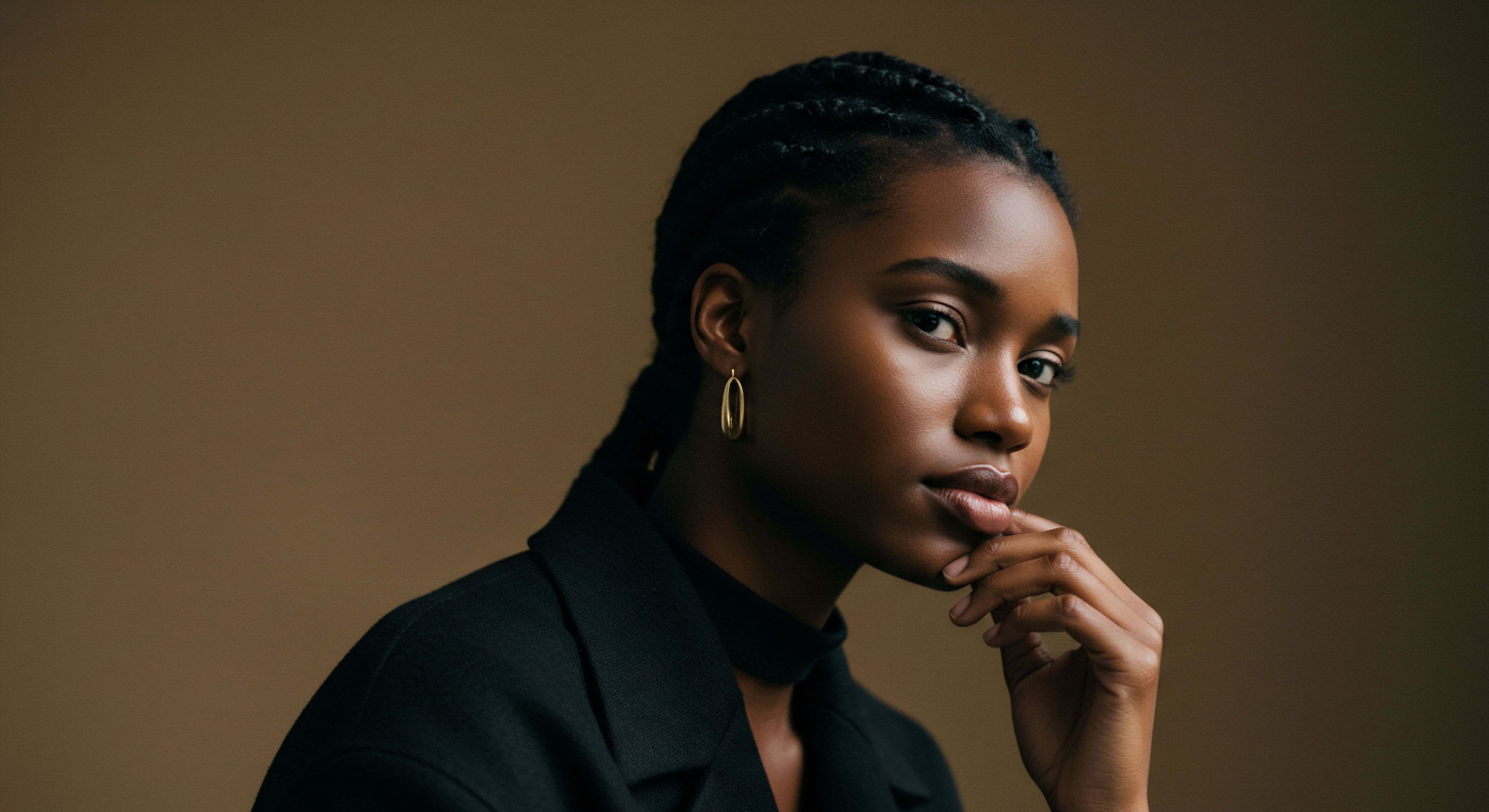
Roots
There is a quiet wisdom that hums beneath the surface of our modern world, a gentle echo from times long past. It speaks of a connection to the earth, to community, and to practices that understood the body as a whole. For those with textured hair, this ancient resonance holds particular meaning. Our strands, with their unique coils and curves, are not merely biological phenomena; they are storytellers, carrying whispers of lineage, resilience, and identity.
When we consider the question of what ancient practices offer tender benefits for modern textured hair care, we are not simply seeking historical anecdotes. We are reaching for foundational understandings, a deeper language that speaks to the very essence of our hair, its structure, and its cycles. This exploration invites us to look beyond fleeting trends and rediscover a grounded approach, one that honors the inherent qualities of our hair.

Hair Anatomy and Its Unique Structure
The journey into understanding textured hair begins at its very core. Each strand, though seemingly simple, is a marvel of biological engineering. At its heart lies the Medulla, a soft, central core, though not present in every hair type. Surrounding this is the Cortex, a dense layer composed of keratin proteins.
These proteins are linked by disulfide bonds, which significantly influence the hair’s strength and shape. The arrangement of these bonds, alongside the elliptical or flattened cross-sectional shape of textured hair, creates its characteristic curl patterns – from gentle waves to tight coils and intricate kinks. This unique geometry means that textured hair possesses more cuticle layers and points of curvature compared to straight hair, rendering it inherently more prone to dryness and breakage. The outermost layer, the Cuticle, consists of overlapping scales that protect the inner cortex. In textured hair, these scales may not lie as flat, contributing to increased porosity and moisture loss.
Understanding these structural differences is paramount. The curly nature means that natural oils produced by the scalp, known as sebum, struggle to travel down the entire length of the hair shaft. This leads to dryness, a common concern for many with textured hair. Moreover, the frequent bends and twists along the strand create points of vulnerability, where the hair is more susceptible to friction and mechanical damage.

How Hair Classification Systems Aid Understanding
Over time, various systems have sought to categorize hair, offering a lexicon for discussion and care. While no single system perfectly captures the vast spectrum of textured hair, they serve as helpful guides. The Andre Walker Hair Typing System, for example, classifies hair into types 1 (straight) through 4 (kinky), with further sub-classifications (a, b, c) based on curl tightness. While widely adopted, critics suggest this system can oversimplify, sometimes leading to comparisons that diminish the beauty of tighter curl patterns.
A more recent approach, the LOIS system, aims for a more descriptive classification based on characteristics like Low, Open, Intermediate, and Shrinkage. This moves beyond mere curl pattern to consider porosity, density, and elasticity, providing a more comprehensive understanding of individual hair needs.
Hair classification systems, while imperfect, offer valuable frameworks for understanding the diverse characteristics of textured hair.
Ultimately, these systems serve as tools, not definitive labels. The true insight arrives when we recognize that hair, even within the same head, can display multiple patterns and properties.
| System Name Andre Walker Hair Typing |
| Primary Focus Curl Pattern |
| Key Characteristics Numbers (1-4) for curl families, letters (a-c) for curl tightness. |
| System Name LOIS System |
| Primary Focus Properties Beyond Curl |
| Key Characteristics Letter designations for Low, Open, Intermediate, Shrinkage; considers porosity, density, elasticity. |
| System Name Naturally Curly Hair Type |
| Primary Focus Curl Shape |
| Key Characteristics Categorizes by wave, curl, and coil definitions. |
| System Name These systems aid in general understanding but individual hair nuances always require personalized attention. |

The Essential Lexicon of Textured Hair
To speak thoughtfully about textured hair care, a shared vocabulary is essential.
- Porosity ❉ This refers to your hair’s ability to absorb and retain moisture. Low porosity hair has tightly bound cuticles, resisting moisture entry but retaining it once inside. High porosity hair has raised cuticles, readily absorbing moisture but losing it just as quickly.
- Elasticity ❉ This is your hair’s ability to stretch and return to its original shape without breaking. Good elasticity indicates healthy, well-hydrated hair.
- Density ❉ This refers to the number of individual hair strands on your scalp. Hair can be fine, medium, or coarse, regardless of its density.
- Breakage ❉ This is when the hair strand snaps along its length, often due to dryness, damage, or improper handling.
- Shedding ❉ This is the natural release of hair from the scalp as part of the hair growth cycle, where the entire strand, including the root, detaches.
Distinguishing between breakage and shedding, for instance, is a fundamental step in addressing hair health concerns. A shower drain full of short, broken pieces suggests a different issue than a collection of long strands with a white bulb at the end.

Hair Growth Cycles and Influencing Factors
Hair growth follows a cyclical pattern, an ongoing process of renewal.
- Anagen Phase ❉ The active growth period, lasting from two to seven years. During this time, hair cells divide rapidly, adding length to the strand.
- Catagen Phase ❉ A transitional period, lasting about two to three weeks, where hair growth stops and the follicle shrinks.
- Telogen Phase ❉ The resting phase, lasting around two to four months, before the old hair sheds and a new one begins to grow.
For textured hair, the anagen phase tends to be shorter compared to other hair types, which can affect overall length retention. Environmental elements, diet, stress, and genetics all significantly influence these cycles. A diet lacking essential nutrients, for example, can disrupt the anagen phase, leading to slower growth or increased shedding.
Chronic stress can push more hairs into the telogen phase prematurely, resulting in noticeable thinning. Understanding these internal and external influences allows for a more holistic approach to hair care, recognizing that true hair wellness extends beyond topical applications.

Ritual
Stepping beyond the foundational understanding of our hair’s inherent qualities, we arrive at the realm of daily and periodic practices. Here, the echoes of ancient wisdom transform into tangible methods, offering a gentle guide for modern textured hair care. These are the routines, the deliberate acts of care, that shape our hair’s experience and contribute to its vitality. The question of what ancient practices offer gentle benefits for modern textured hair care invites us to consider how historical techniques, often rooted in mindful attention and natural resources, can inform our contemporary approaches, moving us towards practices that are both effective and kind to our strands.

Protective Styling Through Time
Across diverse cultures and centuries, protective styles have served as cornerstones of hair care, particularly for textured hair. Styles like Braids, Twists, and Cornrows were not merely aesthetic choices; they were strategic methods for preserving hair length, reducing manipulation, and shielding delicate strands from environmental stressors. In many African societies, these styles carried profound cultural significance, signaling age, marital status, or tribal affiliation.
The benefits of these styles persist today. By gathering sections of hair into contained units, they minimize tangling, friction, and daily handling, which are primary causes of breakage for textured hair. This allows the hair to rest and retain moisture more effectively. Modern adaptations, such as box braids, Senegalese twists, and faux locs, continue this legacy, offering versatility while prioritizing hair health.
It is worth noting, however, that even protective styles require mindful installation and maintenance to avoid excessive tension, which can lead to issues like traction alopecia. Byrd, Ayana D. and Lori L. Tharps.
Hair Story ❉ Untangling the Roots of Black Hair in America. St. Martin’s Press, 2001.

Natural Styling and Definition Techniques
The celebration of natural texture is not a new phenomenon. Historically, communities relied on techniques that enhanced, rather than altered, their hair’s innate curl patterns. Methods such as finger coiling, shingling, or simply allowing hair to air dry after a gentle cleanse were ways to coax out definition. These practices often involved the use of plant-based emollients and humectants to provide moisture and hold without stiffness.
Ancient styling wisdom prioritized working with hair’s natural inclinations, a gentle counterpoint to modern efforts to force alteration.
Today, the popularity of the “wash-and-go” style, while seemingly simple, draws from this principle of working with the hair’s natural inclinations. The focus remains on providing ample hydration and definition to allow coils and curls to clump and present their inherent shape. The key is gentle handling and minimal disturbance during the drying process to prevent frizz and preserve curl integrity.

Wigs and Hair Adornments Across Epochs
The use of wigs and hair extensions is far from a modern invention. Ancient Egyptians, for instance, wore elaborate wigs for protection from the sun, hygiene, and as symbols of status. These were often made from human hair, plant fibers, or wool, and adorned with jewels and gold. In many African cultures, hair was frequently supplemented with natural fibers, beads, or shells, adding length, volume, and symbolic meaning.
Today, wigs and extensions continue to serve multiple purposes for those with textured hair. They offer versatility in styling, allowing for changes in length, color, and texture without altering one’s own hair. Crucially, they can also function as a protective measure, shielding natural hair from daily manipulation and environmental exposure. Proper care of both the extensions and the hair underneath is vital to ensure these modern adaptations truly offer gentle benefits.

Heat Styling and Historical Alterations
The desire to alter hair texture, particularly to straighten it, also has historical roots. Early methods, though crude by modern standards, speak to a long-standing aspiration. In the early 20th century, the hot comb emerged as a significant tool for straightening textured hair, preceding chemical relaxers. This metal comb, heated on a stove, would be passed through the hair, temporarily smoothing coils.
While offering a desired aesthetic, such practices often brought risks of burns and heat damage. Byrd, Ayana D. and Lori L. Tharps.
Hair Story ❉ Untangling the Roots of Black Hair in America. St. Martin’s Press, 2001.
Modern heat styling tools, such as flat irons and curling wands, offer more controlled temperatures and diverse styling options. However, the fundamental principle of applying heat to temporarily alter hair bonds remains. For textured hair, which is already prone to dryness and breakage, excessive or improper heat application can lead to irreversible damage, including loss of curl pattern and increased fragility. A safety-first approach, prioritizing heat protectants and minimal temperatures, is always recommended.

The Complete Textured Hair Toolkit
The tools we use are extensions of our care philosophy. Ancient communities relied on simple, often hand-carved tools that respected the hair’s integrity.
- Wide-Tooth Combs ❉ Historically crafted from wood or bone, these were essential for detangling textured hair gently, minimizing breakage. Modern versions continue this legacy, with materials like plastic or silicone.
- Hair Pins and Adornments ❉ Beyond decoration, pins made from natural materials helped secure styles without causing tension or snagging.
- Natural Fiber Cloths ❉ Soft cloths, perhaps cotton or silk, were likely used to blot excess water from hair, a precursor to modern microfiber towels that reduce friction and frizz.
Today’s toolkit expands to include items like spray bottles for refreshing moisture, satin or silk pillowcases for friction reduction, and diffusers for gentle drying. The wisdom lies not in the complexity of the tool, but in its gentle application and the understanding that it should aid, not hinder, the hair’s natural state.

Relay
As we move deeper into the layered understanding of textured hair care, a profound question emerges ❉ how do ancient wisdoms, often steeped in natural elements and holistic perspectives, intertwine with contemporary scientific insights to truly benefit our strands? This section invites a closer look at the convergence of historical practice, cultural intelligence, and scientific rigor. It is here that the seemingly disparate worlds of ancestral knowledge and modern research meet, offering a rich, interconnected approach to nurturing textured hair. The aim is to move beyond superficial discussions, exploring the intricate dance between our hair’s biology, the products we use, and the broader influences on our well-being.

Building Personalized Textured Hair Regimens
The concept of a personalized regimen, tailored to individual needs, finds echoes in ancient practices where local botanicals and climate conditions dictated care. Modern science affirms this individualized approach, recognizing that hair porosity, density, and elasticity vary greatly, even among those with similar curl patterns. A regimen that suits high porosity hair, which readily absorbs and loses moisture, will differ significantly from one designed for low porosity strands that resist moisture entry.
Creating a thoughtful regimen involves ❉
- Observation ❉ Pay close attention to how your hair responds to different products and environmental conditions. Does it feel dry quickly? Does it easily become weighed down?
- Ingredient Selection ❉ Choose products with ingredients that address your specific porosity and moisture needs.
- Consistent Practice ❉ Regularity in cleansing, conditioning, and moisturizing is more impactful than sporadic, intense treatments.
This blend of attentive observation and informed selection forms the bedrock of truly effective textured hair care. Davis-Sivasothy, Audrey. The Science of Black Hair ❉ A Comprehensive Guide to Textured Hair Care. Sivasothy Publishing, 2011.

The Nighttime Sanctuary Essential Sleep Protection
The practice of covering one’s head at night is a deeply rooted tradition across numerous cultures, serving both practical and symbolic purposes. From ancient Egyptian head coverings to the elaborate wraps of West African communities, these adornments often protected hair from dust, maintained styled looks, and conveyed cultural identity. For textured hair, this practice translates directly into a modern, gentle benefit ❉ sleep protection.
Sleeping on cotton pillowcases can cause significant friction, leading to tangling, frizz, and breakage. Cotton fibers absorb moisture from the hair, exacerbating dryness. The use of Satin or Silk Bonnets, scarves, or pillowcases creates a smooth, low-friction surface that allows hair to glide, preserving moisture and minimizing mechanical damage. This simple yet profound shift in nighttime ritual can dramatically reduce breakage over time, contributing to length retention and overall hair health.
Protecting hair during sleep with smooth fabrics like satin or silk is a modern adaptation of ancient wisdom, safeguarding strands from friction and moisture loss.

Ingredient Deep Dives for Textured Hair Needs
Ancient civilizations instinctively turned to their natural surroundings for remedies, often utilizing plant-based ingredients for cleansing, conditioning, and scalp treatments. Modern science now validates many of these historical choices, revealing the underlying mechanisms that make them so beneficial for textured hair.
Consider the use of plant saponins, found in ingredients like Shikakai ( Acacia concinna ) or Reetha ( Sapindus mukorossi ), long employed in Ayurvedic traditions for gentle hair cleansing. Unlike harsh sulfates, which can strip textured hair of its already limited natural oils, these natural cleansers offer a milder approach. A study on the scalp microbiome found that certain traditional plant-based treatments contribute to a balanced scalp pH and microbiota, potentially reducing fungal overgrowths often seen with harsher modern surfactants. Neuwinger, H.D.
African Ethnobotany ❉ Poisons and Drugs ❉ Chemistry, Pharmacology, Toxicology. Chapman & Hall, 1996. Adebayo, S.K. Ethnobotany of African Plants ❉ Applications for Hair and Skin Care. Nova Science Publishers, 2018.
Another compelling example involves the use of certain plant extracts for promoting scalp health. Research indicates a strong connection between a balanced scalp microbiome and healthy hair growth. A 2021 clinical trial published in Experimental Dermatology observed that 73% of alopecia patients exhibited decreased levels of beneficial bacteria, such as Cutibacterium acnes, while harmful yeasts, like Malassezia restricta, increased.
Individuals who adopted microbiome-friendly hair routines, incorporating gentle cleansers and nutrient-rich serums, reported reduced scalp irritation and visibly thicker hair within a few months. This suggests that traditional practices emphasizing scalp health, often through herbal rinses and oil applications, may have intuitively supported a balanced microbial environment, a concept now gaining significant traction in modern trichology.
| Ancient Ingredient Shikakai ( Acacia concinna ) |
| Traditional Use Gentle cleanser, conditioner |
| Modern Scientific Benefit Natural saponins cleanse without stripping, maintain scalp pH. |
| Ancient Ingredient Amla ( Phyllanthus emblica ) |
| Traditional Use Hair tonic, growth promotion |
| Modern Scientific Benefit Rich in Vitamin C, antioxidants, strengthens hair, improves tensile strength. |
| Ancient Ingredient Neem ( Azadirachta indica ) |
| Traditional Use Anti-dandruff, scalp health |
| Modern Scientific Benefit Antifungal and antibacterial properties combat Malassezia species, support scalp microbiome. |
| Ancient Ingredient Fenugreek ( Trigonella foenum-graecum ) |
| Traditional Use Conditioner, anti-hair fall |
| Modern Scientific Benefit High protein and nicotinic acid content, reduces dandruff, supports growth. |
| Ancient Ingredient These natural elements offer gentle, effective alternatives for textured hair care. |

Textured Hair Problem Solving Compendium
Common concerns for textured hair – dryness, breakage, shedding, and scalp issues – have been addressed by ancient wisdom through centuries. The solutions were often holistic, recognizing the interconnectedness of diet, environment, and external care. For instance, the use of nutrient-rich oils like coconut or olive oil, prevalent in many ancient cultures, directly addresses dryness by providing essential lipids. Modern science confirms these oils can penetrate the hair shaft, reducing protein loss and providing deep conditioning.
Schueller, Randy, and Perry Romanowski. Beginning Cosmetic Chemistry. Allured Business Media, 2009.
Scalp health, a cornerstone of hair wellness, was also a focus. Herbal rinses and poultices were used to soothe irritation, reduce flaking, and maintain a healthy scalp environment. The contemporary understanding of the scalp microbiome reinforces this ancient foresight, highlighting the importance of gentle, balanced care to prevent issues like dandruff and scalp discomfort. Audrey Davis-Sivasothy.
The Science of Black Hair ❉ A Comprehensive Guide to Textured Hair Care. Sivasothy Publishing, 2011.

Holistic Influences on Hair Health
Beyond external applications, ancient wisdom often posited that outer radiance reflected inner well-being. This holistic view of hair health is particularly resonant for textured hair. Dietary practices, stress management, and even mental peace were considered integral to a vibrant appearance. In Ayurvedic tradition, for example, hair is considered a byproduct of bone tissue, implying that bone health and overall nutrition directly affect hair quality.
Neethu, Kesavan. “The Concept of Hair and Hair Care in Ayurveda.” European Journal of Pharmaceutical and Medical Research 8, no. 10 (2021) ❉ 510-513.
Modern research increasingly supports these connections. A diet rich in vitamins, minerals, and proteins is crucial for healthy hair growth. Chronic stress can lead to conditions like telogen effluvium, where hair prematurely enters the resting phase, resulting in increased shedding.
Furthermore, the cultural significance of textured hair means that self-perception and identity also play a subtle, yet powerful, role in how individuals care for their strands. Honoring this interconnectedness means recognizing that gentle care for textured hair extends to nurturing the entire self.

Reflection
As we draw our exploration to a close, the threads of ancient wisdom and modern understanding intertwine, revealing a profound truth ❉ the gentle benefits for modern textured hair care are not found in rigid prescriptions, but in a thoughtful, respectful dialogue between past and present. The intricate structure of our coils and kinks, once seen as a challenge, now stands as a testament to natural beauty, demanding a care that is as nuanced as its form. The historical practices, born from necessity and deep observation, offer us not just techniques, but a philosophy of care – one that values preservation, patience, and a deep connection to the self and the natural world.
We have journeyed through the microscopic world of hair anatomy, glimpsed the rich cultural tapestry of styling, and examined the scientific validation of age-old remedies. The essence of this discovery is a quiet call to listen to our hair, to understand its unique language, and to respond with a gentle touch. It is an invitation to embrace a care regimen that is both informed by scientific discovery and softened by ancestral wisdom, allowing our textured hair to not merely survive, but truly flourish, a radiant expression of its heritage and its inherent splendor.

References
- Byrd, Ayana D. and Lori L. Tharps. Hair Story ❉ Untangling the Roots of Black Hair in America. St. Martin’s Press, 2001.
- Davis-Sivasothy, Audrey. The Science of Black Hair ❉ A Comprehensive Guide to Textured Hair Care. Sivasothy Publishing, 2011.
- LaFlesh, Teri. Curly Like Me ❉ How to Grow Your Hair Healthy, Long, and Strong. John Wiley & Sons, 2010.
- Neuwinger, H.D. African Ethnobotany ❉ Poisons and Drugs ❉ Chemistry, Pharmacology, Toxicology. Chapman & Hall, 1996.
- Neethu, Kesavan. “The Concept of Hair and Hair Care in Ayurveda.” European Journal of Pharmaceutical and Medical Research 8, no. 10 (2021) ❉ 510-513.
- Schueller, Randy, and Perry Romanowski. Beginning Cosmetic Chemistry. Allured Business Media, 2009.
- Adebayo, S.K. Ethnobotany of African Plants ❉ Applications for Hair and Skin Care. Nova Science Publishers, 2018.
- Sadeghian, M. et al. “Cosmetopoeia of African Plants in Hair Treatment and Care ❉ Topical Nutrition and the Antidiabetic Connection?” Diversity 16, no. 2 (2024) ❉ 96.
- Rinaldi, F. et al. “The Scalp Microbiome ❉ How New Hair Loss Treatments Target Bacterial Imbalance.” Experimental Dermatology (2021).
- Gupta, A. et al. “Herbal Remedies for Hair Loss ❉ A Review of Efficacy and Safety.” Karger Publishers (2025).